
Introduction
The advantages of overdrive need no introduction. These days,
driving your Ford Muscle machine on the freeway without overdrive
means revving the heck out of the motor or running late 70's
smog era low numerical rear end gears. Neither choice is attractive
for gas mileage or performance, or what we really want - both.
For this car, a 1971 Mustang originally a 302 car and now packing
a 572 stroked 460, the existing C6 was spinning at well over
3000 rpm to stay with freeway traffic, even with compromise
3.50 gearing. Add the fact that the streetable 2400 stall speed
was well below optimum for a drag strip launch, something more
flexible was called for. The preferable OD manual transmission
rated to handle the torque of a stroked 460 was the six speed,
Viper spec, Tremec T56. A couple quick calculations showed that
the ideal rear end gear with a 28" tall tire and a 6200
rpm shift point would be 4:11 to 1. With the T56's .50 6th gear
the final drive is close to 2:1, meaning a little over 2000
rpm at 75 MPH. Talk about having your cake and eating it too.
The only problem with the T56 swap is that Ford only offered
the 429 engine in one model year of Mustang, 1971. Therefore
there is a lack of instruction and guidance on performing the
T56 graft into this year Mustang. That is, until this article.
Myth Busting
Myth #1 - A manual transmission means weight savings.
We all know the Ford C6 is tough but heavy. How heavy? On the
authors' handy physician's scale the C6 with converter, flexplate
and fluid weighed 218 lbs. The T56 with fluid weighs only 128,
but add the NHRA mandated scatter shield (55 lbs.), steel flywheel
and twin disk clutch assembly (48 lbs.) and the stick tranny
is actually heavier than the C6 by 13 lbs. You can save a little
weight during the conversion using an aluminum flywheel.
Myth #2 - Mounting a T56 behind a 460 requires a custom adapter.
For this project, the turning point was the introduction of
the McLeod modular steel bellhousing. This meant a straight
forward bolt up of the T56 to the back of the 460 and the avoidance
of custom machined adapters.
Myth #3 - The C6 is huge, if it fits
so will anything else.
While it's true the high bellhousing mounting pattern on the
429-460 and the M family of Ford engine takes up a lot of
space, but the automatic

While comparable in length, the
T56 case has greater bulk, requiring transmission tunnel
modifications. |
transmission tapers off quickly. The manual's six beefy forward
gears and the internal shifter rail takes up more room front
to back and adds height back where the vintage transmission
tunnel really begins to narrow. Also complicating the issue
is that the transmission mount is six inches further back than
the location used by the older autos and sticks in vintage iron.
The case size stays large back through the sheet metal tunnel
brace common to earlier Fords.
The easy fix is to tilt the engine a bit more to get the T56
under the tunnel, but this would mean reduced ground clearance
for the headers and transmission, as well as bad driveshaft
angles resulting in vibrations. The other issue is the location
of the internal shifter. There are two shifter pads on the T56
but both tend to be forward of the typical pony car or mid size
Ford shifter location. There are now shifter extensions which
add a lever on the tunnel with a link to the actual shift lever,
but these would look funky in a vintage muscle car and preclude
using a factory console. The other choice is to cut a new hole
for the shifter, but again this leaves no room for the factory
console and a knuckle busting long stretch for third and fifth
gear.
The ideal solution was to set the engine back 1.75" and
down .75". This sounds worse than it is as in a '71 Mustang
the engine has plenty of room to move back without touching
the firewall or moving vital components. It does require some
surgery on the tunnel brace but it puts the shifter in the original
location and made the drive shaft angles almost nonexistent.
One step at a time
After putting the wheels in motion and waiting for the
first production run of the new modular bellhousing to go
through quality control I was faced with the decision to do
the job of fitting an untried combination from under the car
or going through the hassle of pulling the engine and mocking
up the install out of the car.

The transmission was mocked up
on a stand with a spare 460 motor. Slight grinding of
the bellhousing flanges was required to clear the headers. |
Fate intervened in the form of three spun cam bearings, the
assorted bent valves, sheared timing gear pin and other fun
stuff that comes with parts that suddenly stop rotating at freeway
speeds. With the engine out and off to the machine shop, a borrowed
block and heads stood in and allowed the transmission/bellhousing
assembly to be test fit on a stand and then in the car. This
scenario also worked to my advantage in that I had plent of
space to make all the necessary sheet metal, mounting, and clutch
modifications.
Clutch and Pedals

The '71 clutch pedal assembly was
sourced from Perogie Enterprises. |
The odds of finding a '71 Mustang big-block bell crank linkage
and pedal assembly in the wrecking yard are less than winning
the lotto. Rather than waste time and money searching for an
out-dated clutch actuation mechanism I took the opportunity
to install a Mcleod hydraulic clutch setup. All that remained
was sourcing a pedal assembly. Fortunately shops like Perogie
Enterprises usually have complete assemblies for sale.
Another McLeod sourced #4 hose connects the clutch master
cylinder to the slave cylinder mounted around the input shaft.
The constant engagement throw-out bearing presses against
the McLeod Street Twin clutch ensuring almost instant disengagement
when the pedal is pressed. (T56 slave cylinder installed )
The Street Twin is a two disk system designed to hold big
block torque without requiring a power lifters leg muscles.
The small diameter diaphragm clutch only needs a half inch
of travel which is supplied by a one inch stroke at the clutch
master cylinder or about three inches of pedal travel.

 Rather then search for factory
mechanical clutch linkage a McLeod hydraulic assembly
was selected. The kit included a Wilwood clutch master
cylinder. Shown in image #8 are the slave cylinder, throwout
bearing and hoses.
Rather then search for factory
mechanical clutch linkage a McLeod hydraulic assembly
was selected. The kit included a Wilwood clutch master
cylinder. Shown in image #8 are the slave cylinder, throwout
bearing and hoses. |

 The clutch master cylinder will
be mounted in the engine bay. Some precut ProFab tabs,
a piece of tube, a few rod ends and hardware store bronze
bushings pivoting on an axle bolt made for a compact bell
crank. A piece of scrap stainless tube, left and right
hand .375” fine thread nuts and two surplus heim
ends make up the clutch pull rod.
The clutch master cylinder will
be mounted in the engine bay. Some precut ProFab tabs,
a piece of tube, a few rod ends and hardware store bronze
bushings pivoting on an axle bolt made for a compact bell
crank. A piece of scrap stainless tube, left and right
hand .375” fine thread nuts and two surplus heim
ends make up the clutch pull rod. |
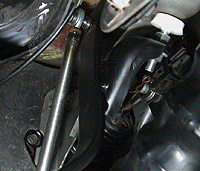
 The upper end of the clutch pull
rod attaches to the top of the clutch pedal on a welded
stud. Stepping on the pedal pulls the rod up which pushes
the master cylinder rod inwards, forcing fluid to the
throwout bearing, in turn depressing the clutch fingers
and releasing the disc.
The upper end of the clutch pull
rod attaches to the top of the clutch pedal on a welded
stud. Stepping on the pedal pulls the rod up which pushes
the master cylinder rod inwards, forcing fluid to the
throwout bearing, in turn depressing the clutch fingers
and releasing the disc. |

 The clutch pull rod passes through
a hole cut in the steering shaft mount plate. That's the
steering shaft boot on the right. An additional piece
of aluminum is used to add rigidity to the plate.
The clutch pull rod passes through
a hole cut in the steering shaft mount plate. That's the
steering shaft boot on the right. An additional piece
of aluminum is used to add rigidity to the plate. |

 In order for Wilwood master cylinder
to fit between the steering box and the side wall of the
engine compartment, the bulky factory steering rag-joint
was replaced with a Borgeson
universal assembly.
In order for Wilwood master cylinder
to fit between the steering box and the side wall of the
engine compartment, the bulky factory steering rag-joint
was replaced with a Borgeson
universal assembly. |
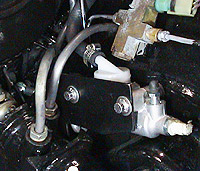
 The hydraulic clutch master cylinder
is a tight fit and power steering lines had to be rerouted
to make clearance.
The hydraulic clutch master cylinder
is a tight fit and power steering lines had to be rerouted
to make clearance. |
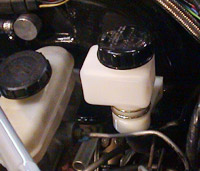
 The hydraulic fluid for the clutch
master cylinder is mounted next to the brake master cylinder.
The hydraulic fluid for the clutch
master cylinder is mounted next to the brake master cylinder. |
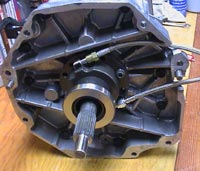
 The slave cylinder has two #4 braided
steel hydraulic lines. The pressure line connects to the
master cylinder and the bleed line is terminated with
a bleeder scew.
The slave cylinder has two #4 braided
steel hydraulic lines. The pressure line connects to the
master cylinder and the bleed line is terminated with
a bleeder scew. |

 A brake pressure switch is T'd into the pressure line
and acts as the "neutral" safety switch. The
clutch must be depressed for the car to start. This approach
will pass tech inspection at NHRA and IHRA tracks.
A brake pressure switch is T'd into the pressure line
and acts as the "neutral" safety switch. The
clutch must be depressed for the car to start. This approach
will pass tech inspection at NHRA and IHRA tracks.
|
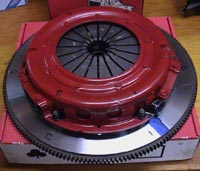
 McLeod's Red Roberts helped select the right clutch, their
Street Twin clutch and 30lb flywheel. ensuring almost
instant disengagement when the pedal is pressed.
McLeod's Red Roberts helped select the right clutch, their
Street Twin clutch and 30lb flywheel. ensuring almost
instant disengagement when the pedal is pressed. |
|
 (Engine Setback)
(Engine Setback) |
| |
|
|
|
|
|
|
| |
|
In This Article:
The advantage of overdrive transmissions are
so great that no vintage Ford should go without
one. You have choices, be it automatic, manual,
or an add-on unit. We show you how to go for
broke by installing the big daddy of sticks,
the Viper-spec T56 six speed, in a 1971 Mustang.
We'll also detail how to convert to a hydraulic
clutch and move the motor back.
|
|
|
| |
|
| |

The Tremec T-56 is a six-speed manual
transmission with 5th and 6th gears being overdriven at 0.74
and 0.50 respectively. Originally equipment for Dodge Vipers,
this unit is rated to handle 650 lb-ft. of torque. In reality
it probably handles a good deal more, and is the perfect choice
for big cubic-inch Fords. Photo:
D&D Transmissions |
| |
|
| |
|
| |
|
| |
| So you want to OD? |
You've
got choices. You can go automatic overdrive such as
AOD, E4OD, or be a sacrilege and use a GM 200R4. If
you want to row gears there's the T5, TKO and T56, not
to mention Richmond and others. Finally there are add
on units from Gear Vendors and US Gear. Each has positives
and negatives to consider.
Automatics
With a three speed automatic faster quarter mile times
and that fast launch means a high stall converter, more
slippage, more heat and real compromise for any car
that's supposed to be a do it all driver. Overdrive
automatics add an additional gear, but still need a
higher stall converter for effective drag strip launches
and the lock up feature that holds down converter slippage
and increases highway efficiency is often the first
to go to keep a serious AOD or other overdrive auto
in one piece.
Sticks
With a stick shift you have almost infinite control
over launch rpm and with a clutch there's no slippage.
The mechanical coupling from engine to transmission
means reduced parasitic power loss. For bracket racers
a stick is a real challenge to consistency, and there's
the fun of driving in bad traffic.
Add-on Units
The add on units give another set of gearing to an automatic
or stick and are very reliable, but they can be hard
to package in a tight transmission tunnel and aren't
inexpensive either. They allow you to preserve an existing
set up with adjustments to mounts and driveshaft length.
They are generally not used in racing due to the challenges
of shifting two units. |
|
| |
|
| |
|
|
|

